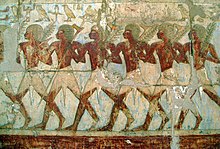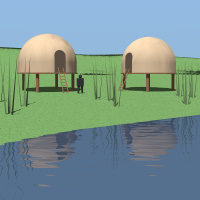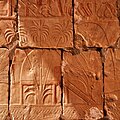Land of Punt
Land of Puntis a name for a place found inAncient Egyptiantexts.At times it is also calledPwenetorPwene.[1]People from Ancient Egypt traded with this place from 6.000 BC. It was known for producing and sellinggold,aromaticresins,blackwood,ebony,ivory,and wild animals. The region is known from ancient Egyptian texts because people went there to trade.[2]Some teachers of the bible think that it is the same as the biblical land ofPut.[3]
At times Punt is calledTa netjer,the "Land of the God".[4]
It is not known where exactly this place was. Most scholars today believe Punt was to the southeast of Egypt, most likely in the coastal region of what is todaySomalia,Djibouti,Eritrea,northeastEthiopiaand theRed Seacoast ofSudan.[5]However, some scholars point instead to other ancient writings which say Punt was in theArabian Peninsula.[6]It is also possible that the territory covered both theHorn of Africaand Southern Arabia.Puntland,the Somali administrative region at the edge of the Horn of Africa, is named in reference to the Land of Punt.[7]
Inhabitants formed three groups which wore different clothing, and hairstyles. They heldcattleand lived instilt houses.Starting from theNileacaravancould reach Punt in five days.
Tomb
[change|change source]- Reliefs in the Temple of Hatshepsut
A tomb was discovered in the 19th century;[8]however, it was neglected. In 2003, in response to concerns about its deterioration,[8]it was cleaned by BritishEgyptologistsand was found to contain an 22-line inscription with important historical significance.[9][10][11]The inscription was made with red paint on the doorway between the two internal chambers.[9][10][11]
It records a massiveNubianinvasion, aided by peoples from the land of Punt and theMedjay,[12]on the small and fragile 16th or 17th Dynasty city state ofThebes.Sobeknakht IIclaims to have strengthened El-Kab's defenses, got a fighting force, and launched a counter-attack, which was victorious due to the aid of thevulture-goddessNekhbet[12][10][11]A celebration is attended by an unnamed Egyptian king, and Sobeknakht endows the temple of Nekhbet with "a new sacred barque worked in electrum."[12]
A vessel with Sobeknakht's name was discovered inSudan,which seems to match the events depicted.[8]It also hints that Sobeknakht's tomb had already been filled and finished by the time of the invasion, and that the red text was added as a late addition to reflect these new events in his life, the corridor being the only remaining space left.[8]
Egyptian expeditions to Punt
[change|change source]


The earliest recorded Egyptian expedition to Punt was organized byPharaohSahureof theFifth Dynasty(25th century BC). Gold from Punt was in Egypt as early as the time of PharaohKhufuof theFourth Dynasty.[13]
Egyptian trade
[change|change source]There were more expeditions to Punt in theSixth,Eleventh,TwelfthandEighteenthdynasties of Egypt. In the Twelfth Dynasty, trade with Punt was celebrated in popular literature in theTale of the Shipwrecked Sailor.
In theEighteenth Dynasty of Egypt,Hatshepsutbuilt aRed Seafleet to make it easier to trade between the head of theGulf of Aqabaand south as far as Punt to bringmortuarygoods toKarnakin exchange forNubiangold. Hatshepsut personally made the most famous ancient Egyptian expedition that sailed to Punt. During the reign ofQueen Hatshepsutin the 15th century BC, ships regularly crossed theRed Seain order to getbitumen,copper,carvedamulets,napthaand other goods transported overland and down theDead SeatoElatat the head of thegulf of Aqabawhere they were joined withfrankincenseandmyrrhcoming north both by sea and overland along trade routes through the mountains running north along the east coast of the Red Sea.[14]
A report of that five-ship voyage can still be seen onreliefsin Hatshepsut's mortuarytempleatDeir el-Bahri.[15]Throughout the temple texts, Hatshepsut "maintains the fiction that her envoy" ChancellorNehsi,who is mentioned as the head of the expedition, had travelled to Punt "in order to extract tribute from the natives" who admit their allegiance to the Egyptian pharaoh.[16]In reality, Nehsi's expedition was a simple trading mission to a land, Punt, which was by this time a well-established trading post.[16]Moreover, Nehsi's visit to Punt was not so brave since he was "accompanied by at least five shiploads of [Egyptian] marines" and greeted warmly by the chief of Punt and his immediate family.[15][16]The Puntites "traded not only in their own produce of incense, ebony and short-horned cattle, but [also] in goods from other African states including gold, ivory and animal skins."[16]According to the temple reliefs, the Land of Punt was ruled at that time by King Parahu and Queen Ati.[17]This well illustrated expedition of Hatshepsut occurred in Year 9 of the female pharaoh's reign with the blessing of the godAmun:
Said by Amen, the Lord of the Thrones of the Two Land: 'Come, come in peace my daughter, the graceful, who art in my heart, King Maatkare [ie. Hatshepsut]...I will give thee Punt, the whole of it...I will lead your soldiers by land and by water, on mysterious shores, which join the harbours of incense...They will take incense as much as they like. They will load their ships to the satisfaction of their hearts with trees of green [ie. fresh] incense, and all the good things of the land.'[18]
The Egyptians were not good at travelling at sea. For them, the travel to Punt must have been similar to modern-day explorers travelling to the moon. But the reward of obtaining frankincense, ebony and myrrh clearly outweighed the risks.[19]Hatshepsut's 18th dynasty successors, such asThutmose IIIandAmenhotep IIIcontinued the tradition of trading with Punt.[20]The trade with Punt continued into the start of the 20th dynasty.[20]Papyrus Harris I,a contemporary Egyptian document which detailed events that occurred in the reign of the early 20th dynasty kingRamesses III,includes an explicit description of an Egyptian expedition's return from Punt:
They arrived safely at the desert-country ofCoptos:they moored in peace, carrying the goods they had brought. They [the goods] were loaded, in travelling overland, uponassesand upon men, being reloaded into vessels at the harbour of Coptos. They [the goods and the Puntites] were sent forward downstream, arriving in festivity, bringing tribute into the royal presence.[21]
After the end of theNew Kingdom of Egyptperiod, Punt became "an unreal and fabulous land of myths and legends."[22]
Ta netjer
[change|change source]At times, theancient Egyptianscalled PuntTa netjer,meaning "God's Land".[23]It was among the regions of theSun God,that is, the regions in the direction of the sunrise, to the East of Egypt. These eastern regions' resources included products used in temples, notablyincense.Older literature (and current non-mainstream literature) said that the label "God's Land" meant that the ancient Egyptians viewed the Land of Punt as their ancestral homeland. W. M.Flinders Petriebelieved that theDynastic Racecame from or through Punt[24]andE. A. Wallis Budgesaid that "Egyptian tradition of the Dynastic Period held that the aboriginal home of the Egyptians was Punt...".[25]The term was not only applied to Punt, located southeast of Egypt, but also to regions ofAsiaeast and northeast of Egypt, such asLebanon,which was the source of wood for temples.[26]
Queen Ati, shown in the reliefs ofHatshepsut,shows advancedSteatopygia,associated though not limited toKhoi-Sanpeople of East and South Africa. It has been suggested that this may be evidence of the survival of Khoi-San cultures since theSangoanculture in North Eastern Africa prior to the arrival ofCushiticspeaking cultures in the region.[27]
Location
[change|change source]
The products of Punt (as they are shown in Hatshepsut's temple) are easily found in theHorn of Africa.They are less common or absent inArabia.For this reason, most scholars think that Punt was in Northeast Africa. These products included gold and aromatic resins such asmyrrh,frankincense,andebony;the wild animals depicted in Punt includedgiraffes,baboons,Hippopotamus,andleopards.According to Richard Pankhurst: "[Punt] has been identified with territory on both the Arabian and the Horn of Africa coasts. Consideration of the articles which the Egyptians obtained from Punt, notably gold and ivory, suggests, however, that these were primarily of African origin.... This leads us to suppose that the term Punt probably applied more to African than Arabian territory."[2][16][28][29]
Some scholars disagree with this view and point to a range of ancient inscriptions which locate Punt in Arabia.Dimitri Meekshas written that "Texts locating Punt beyond doubt to the south are in the minority, but they are the only ones cited in the current consensus about the location of the country. Punt, we are told by the Egyptians, is – in relation to the Nile Valley – both to the north, in contact with the countries of the Near East of the Mediterranean area, and also to the east or south-east, while its furthest borders are far away to the south. Only the Arabian Peninsula satisfies all these indications."[6]
In 2010, a genetic study was conducted on the mummified remains ofbaboonsthat were brought back from Punt by the ancient Egyptians. Led by a research team from theEgyptian Museumand theUniversity of California,the scientists used oxygenisotopeanalysis to examine hairs from two baboonmummiesthat had been preserved in theBritish Museum.One of the baboons had distortedisotopicdata, so the other's oxygen isotope values were compared to those of modern-day baboon specimens. The researchers at first found that the mummies most closely matched modern specimens seen inEritreaandEthiopiaas opposed to those in neighbouring Somalia, with the Ethiopian specimens "basically due west from Eritrea". The team did not have the opportunity to compare the mummies with baboons inYemen.The scientists believed that such an analysis would yield similar results since, according to them, regional isotopic maps suggest that baboons in Yemen would closely resemble those in Somalia. Professor Dominy, one of the lead researchers, concluded from this that "we think Punt is a sort of circumscribed region that includes eastern Ethiopia and all of Eritrea."[30]In 2015, the scientists conducted a followup study to confirm their initial findings, and concluded that "our results reveal a high likelihood match with eastern Somalia and the Eritrea-Ethiopia corridor, suggesting that this region was the source ofPapio hamadryasexported to Ancient Egypt. "[31]
Egyptian spelling "pwenet" it should be noted that the feminine "t" ending was not pronounced during the New Kingdom the last sign is the determinative forcountry,land |
 Wall relief |
 Huts as in relief |
Notes
[change|change source]- ↑Ian Shaw & Paul Nicholson,The Dictionary of Ancient Egypt,British Museum Press, London. 1995, p.231.
- ↑2.02.1Shaw & Nicholson, p.231.
- ↑Sadler, Jr., Rodney (2009). "Put". In Katharine Sakenfeld (ed.).New Interpreter's Dictionary of the Bible.Vol. 4. Nashville: Abingdon Press. pp. 691–92.
- ↑Breasted, John Henry (1906–1907), Ancient Records of Egypt: Historical Documents from the Earliest Times to the Persian Conquest, collected, edited, and translated, with Commentary, p.433, vol.1
- ↑Simson Najovits,Egypt, trunk of the tree, Volume 2,(Algora Publishing: 2004), p.258.
- ↑6.06.1Dimitri Meeks – Chapter 4 – "Locating Punt" from the bookMysterious Lands",by David B. O'Connor and Stephen Quirke.
- ↑Puntland profile, BBC News.https://www.bbc.com/news/world-africa-14114727
- ↑8.08.18.28.3Cite error: The named reference
web.archive.orgwas used but no text was provided for refs named (see thehelp page). - ↑9.09.1"Tomb reveals Ancient Egypt's humiliating secret - Times Online".6 July 2008. Archived fromthe originalon 2008-07-06.Retrieved28 July2022.
- ↑10.010.110.2Davies, Vivian (2003). "Sobeknakht of Elkab and the coming of Kush".Egyptian Archaeology.23:3–6.
- ↑12.012.112.2Cite error: The named reference
osirisnet.netwas used but no text was provided for refs named (see thehelp page). - ↑Breasted 1906–07, p. 161, vol. 1.
- ↑Dr. Muhammed Abdul Nayeem, (1990). Prehistory and Protohistory of the Arabian Peninsula. Hyderabad. ISBN.
- ↑15.015.1Tyldesley, Hatchepsut, p.149
- ↑16.016.116.216.316.4Tyldesley, Hatchepsut, p.147
- ↑Breasted 1906–07, pp. 246–295, vol. 1.
- ↑E. Naville, The Life and Monuments of the Queen in T.M. Davis (ed.),the tomb of Hatshopsitu,London: 1906. pp.28–29
- ↑Tyldesley, Hatchepsut, p.148
- ↑20.020.1Tyldesley, Hatchepsut, pp.145–146
- ↑K. A. Kitchen, "Punt and how to get there",Orientalia40 (1971), 184–207:190.
- ↑Tyldesley,Hatchepsut,p.146
- ↑Breasted 1906–07, p. 658, vol. II.
- ↑"The Making of Egypt" (1939) states that the Land of Punt was "sacred to the Egyptians as the source of their race."
- ↑Short History of the Egyptian People, by E. A. Wallis Budge. Budge stated that "Egyptian tradition of the Dynastic Period held that the aboriginal home of the Egyptians was Punt..."
- ↑Breasted 1906–07, p. 451,773,820,888, vol. II.
- ↑D.W. Phillipson. 2005. African archaeology, page 81 of 389 pages
- ↑Pankhurst, Richard (2001).The Ethiopians: A history.Wiley.ISBN978-0-631-22493-8.
- ↑Hatshepsut's Temple at Deir El Bahari By Frederick Monderson
- ↑Owen Jarus,"Baboon mummy analysis reveals Eritrea and Ethiopia as location of land of Punt".The Independent.26 April 2010. Archived fromthe originalon 14 March 2011.Retrieved26 April2010.
- ↑NATHANIEL J. DOMINY1, SALIMA IKRAM, GILLIAN L. MORITZ, JOHN N. CHRISTENSEN, PATRICK V. WHEATLEY, JONATHAN W. CHIPMAN."Mummified baboons clarify ancient Red Sea trade routes".American Association of Physical Anthropologists. Archived fromthe originalon 30 July 2016.Retrieved14 June2016.
{{cite web}}:CS1 maint: multiple names: authors list (link) CS1 maint: numeric names: authors list (link)
References
[change|change source]- Bradbury, Louise (1988), "Reflections on Travelling to 'God's Land' and Punt in the Middle Kingdom",Journal of the American Research Center in Egypt,25:127–156,doi:10.2307/40000875,JSTOR40000875.
- Breasted, John Henry(1906–1907),Ancient Records of Egypt: Historical Documents from the Earliest Times to the Persian Conquest, collected, edited, and translated, with Commentary,vol. 1–5, University of Chicago Press.
- El-sayed, Mahfouz (2010)."Amenemhat IV au ouadi Gaouasis"(PDF).BIFAO.110:165–173. Archived fromthe original(PDF)on 2016-09-18.
- Fattovich, Rodolfo. 1991. "The Problem of Punt in the Light of the Recent Field Work in the Eastern Sudan". InAkten des vierten internationalen Ägyptologen Kongresses, München 1985,edited by Sylvia Schoske. Vol. 4 of 4 vols. Hamburg: Helmut Buske Verlag. 257–272.
- ———. 1993. "Punt: The Archaeological Perspective". InSesto congresso internazionale de egittologia: Atti,edited by Gian Maria Zaccone and Tomaso Ricardi di Netro. Vol. 2 of 2 vols. Torino: Italgas. 399–405.
- Herzog, Rolf. 1968.Punt.Abhandlungen des Deutsches Archäologischen Instituts Kairo, Ägyptische Reihe 6. Glückstadt: Verlag J. J. Augustin.
- Kitchen, Kenneth(1971), "Punt and How to Get There",Orientalia,40:184–207
- Kitchen, Kenneth (1993), "The Land of Punt", in Shaw, Thurstan; Sinclair, Paul; Andah, Bassey; et al. (eds.),The Archaeology of Africa: Foods, Metals, Towns,vol. 20, London and New York: Routledge, pp. 587–608.
- Meeks, Dimitri (2003), "Locating Punt", in O'Connor, David B.; Quirke, Stephen G. J. (eds.),Mysterious Lands, Encounters with ancient Egypt,vol. 5, London: Institute of Archaeology, University College London, University College London Press, pp. 53–80,ISBN1-84472-004-7.
- Paice, Patricia (1992), "The Punt Relief, the Pithom Stela, and the Periplus of the Erythean Sea", in Harrak, Amir (ed.),Contacts Between Cultures: Selected Papers from the 33rd International Congress of Asian and North African Studies, Toronto, 15–25 August 1990,vol. 1, Lewiston, Queenston, and Lampeter: The Edwin Mellon Press, pp. 227–235.
- O'Connor, David (1994),Ancient Nubia: Egypt's Rival in Africa,University of Pennsylvania Press, pp. 41–44.
- Wicker, F. D. P. (July, 1998), "The Road to Punt",The Geographical Journal.Vol. 164, no. 2. 155-167
Older literature
[change|change source]- Johannes Dümichen:Die Flotte einer ägyptischen Königin,Leipzig, 1868.
- Wilhelm Max Müller:Asien und Europa nach altägyptischen Denkmälern,Leipzig, 1893.
- Adolf Erman:Life in Ancient Egypt,London, 1894.
- Édouard Naville:"Deir-el-Bahri" inEgypt Exploration Fund, Memoirs XII, XIII, XIV, and XIX,London, 1894 et seq.
- James Henry Breasted:A History of the Ancient Egyptians,New York, 1908.
Other websites
[change|change source]- The Land of Puntwith quotes from Breasted (1906) and Petrie (1939)Archived2007-08-08 at theWayback Machine
- Queen Hatasu, and Her Expedition to the Land of PuntArchived2023-05-06 at theWayback Machineby Amelia Ann Blanford Edwards (1891)
- Deir el-Bahri: Mortuary Temple of Hatshepsut
- Hall of Puntat Deir el-Bahri; andWhere was Punt?discussion by Dr. Karl H. Leser
- Queen of Punt syndrome
News reports on Wadi Gawasis excavations
[change|change source]- Archaeologists discover ancient ships in Egypt(Boston University Bridge, 18 March 2005). Excavations at Wadi Gawasis, possibly the ancient Egyptian port Saaw.
- Remains of ancient Egyptian seafaring ships discoveredArchived2008-10-08 at theWayback Machine(New Scientist, 23 March 2005).
- Sailing to distant lands(Al Ahram, 2 June 2005).Archived23 September 2012 at theWayback Machine
- Ancient ship remains are unearthed(Deutsche Press Agentur, 26 January 2006).Archived8 December 2012 atArchive.today
- 4,000-year-old shipyard unearthed in Egypt(MSNBC, 6 March 2006).



